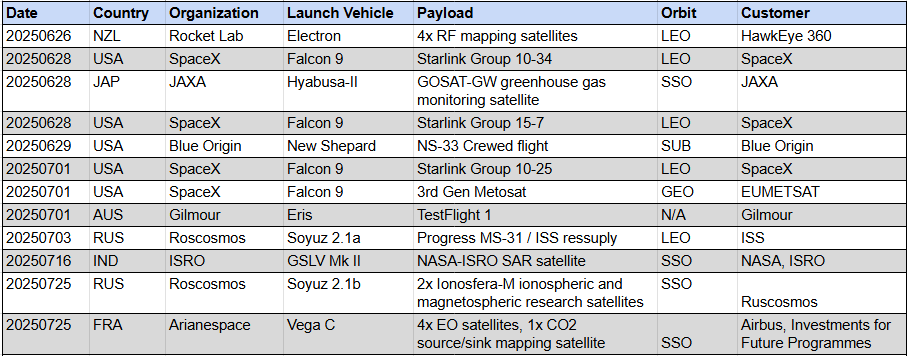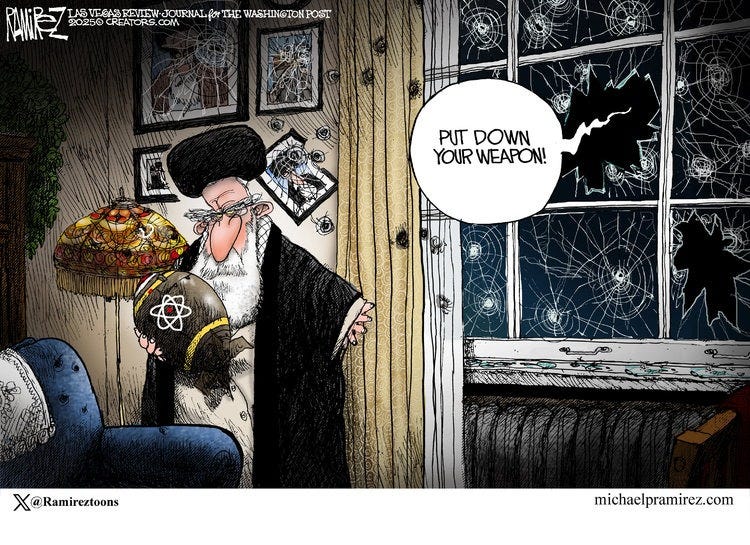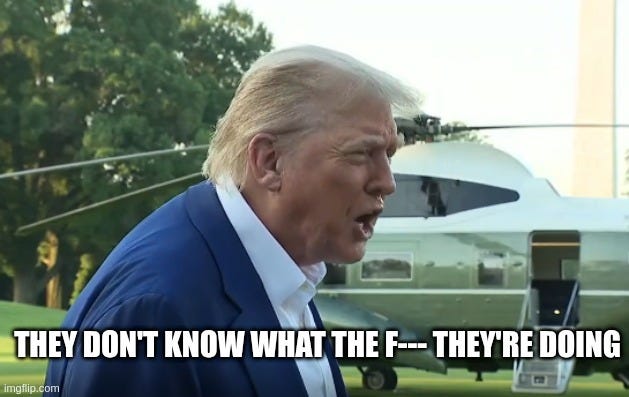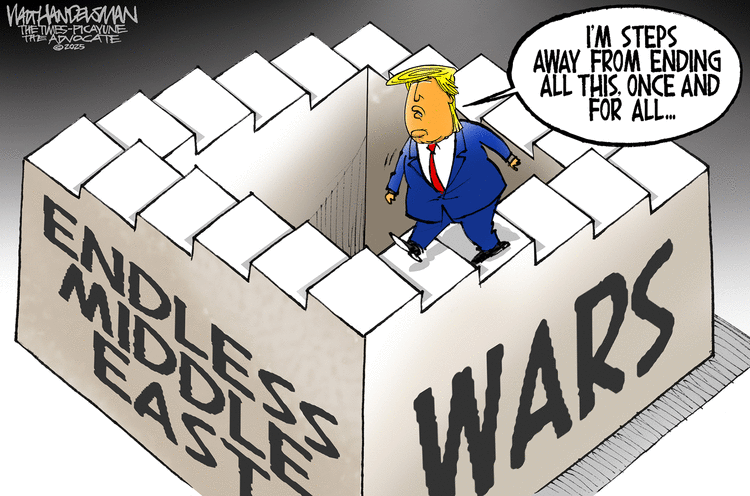Super Secret Squirrel Intel and the Risks to National Security
Did U.S. strikes set back Iran’s nuclear program—or just scatter it into the shadows?
Good morning,
Drama continues at the Pentagon as official military assessments find that U.S. strikes damaged but did not destroy Iran’s nuclear sites and likely only set back the program by several months. This has seemingly incensed President Trump and Secretary Hegseth, who has voluntarily adopted the role of Cheerleader-in-Chief for the President. Trump has claimed access to Super Secret-Squirrel (that’s above Top Secret) Intelligence from Israeli operatives that allegedly entered Fordow after the strikes and reported back to him that the site was in a state of ‘total obliteration.’
Israeli officials have denied that any operatives entered any of the sites, which makes sense as satellite imagery clearly shows ‘extensive damage’ done to the tunnel entrances, as reported by the IAEA. That, and, you really wouldn’t send a human into a potentially highly contaminated facility without sending robots in first to detect radiation.
Iran, for its part, admits heavy damage to (yet not destruction of) its program. But, that’s what you’d expect a regime to say if it were faced with extinction over a nuclear program that it now wants to hide.
This raises the question then of what’s the truth? It’s likely somewhere between ‘damaged’ and ‘obliterated.’ We’d guess that the program has been set back significantly—on the order of 6 months to 2-3 years.
Having said that, there are a few, important caveats.
There likely remains some operationally-capable centrifuges at the sites, meaning there is some enrichment capability remaining.
More impactful than the damage to the sites from dropping GBU-57s is likely the deaths of several high-profile leaders of the Sazman-e Pazhouheshhaye Novin-e Defa’i (SPND)—Iran’s equivalent to DARPA, tasked with running its nuclear development program. These important researchers held the institutional knowledge for design and development.
Due to the conflict, the IAEA admitted that it could not account for Iran’s stockpile of highly-enriched uranium, more than 400kg of 60% Uranium-235. It is probable that Iran moved it prior to the strikes.
Iran told the IAEA on June 13th that it intended to ‘adopt special measures to protect our nuclear equipment and materials’ with no further details.
Satellite imagery from Maxar showed a flurry of ‘unusual activity’ including truck and vehicular activity at Fordow in the 72 hours prior to the U.S. strikes.
The IAEA says it cannot account for the material.
U.S. Vice President J.D. Vance conceded that the U.S. didn’t know if Iran had moved the material prior to the strikes.
Iran claimed to have moved it prior to the strike.
European intelligence assess the material was moved prior to the strikes.
An Israeli security ‘source’ reported that the country knows there whereabouts of the stockpile.
We believe that Iran likely relocated at least some of its highly enriched uranium (60%) prior to the strikes. And it matters for two reasons.
First, while it may sound like a big jump to enrich uranium from 60% to 90%, in reality its far easier to make this jump than to enrich naturally occurring uranium to 20% enriched. It takes about 10x more effort to get uranium enriched to 20% than to enrich it from 60% to 90%.
Second—and perhaps more importantly—it raises concerns about transparency in our own government.
Secretary Hegseth has said that he’s unaware of any intelligence supporting claims that Iran moved uranium. He’s also contradicted the military intelligence report on the extent of damage to the strike targets. That’s only possible if you’ve closed your eyes and ears to publicly available information and to U.S. intelligence.
Director of Central Intelligence John Ratcliffe claims that the CIA assesses ‘severe damage’ to the three nuclear sites struck by U.S. forces and nuclear program, potentially contradicting the Defense Intelligence Agency report. Of course, Ratcliffe is also the same person that lied to Congress about Hegseth sharing classified information in a Signal chat group.
For his part, the President seems willing to indulge his confirmation biases, cherrypicking intelligence that reinforces that he is the best thing since sliced bread (he’s not, this is the list of best things since sliced bread).
But approaching national security with blinders on is incredibly dangerous and foolish. We need accuracy in our intelligence so that we can make properly informed decisions. Otherwise, we risk overlooking risks and hurting innocents. It is antithetical to the American way of war and to Western values.
Alright, on to the news!
News Headlines
A SpaceX Starship exploded during testing last week at Starbase in Texas (AP)
Iran remains security threat even after airstrikes: CENTCOM (DN)
Early U.S. intel report suggest U.S. strikes only set back Iran's nuclear program by months (AP)
Pentagon launches probe into Iran strike intel leak (POL)
Democratic socialist Zohran Mamdani upsets primaries to emerge as lead democratic candidate for NYC mayoral race (NPR)
The U.S. economy is losing momentum, forcing some Fed policymakers to consider earlier rate cut, which could risk stagflation (BBG)
Satellites
Launches
Upcoming Launches
Space News
NASA’s acting leadership is planning an organizational overhaul (SN)
Mexican president Claudia Sheinbaum threatens to sue over SpaceX rocket explosion debris (TG)
SpaceX launches 4 people into orbit on Axiom Space Ax-4 mission to ISS (NPR)
Space Force Rapid Capability Office to launch first 'full-up' satellites soon (ASF)
Space Command Chief talks Golden Dome, Electromagnetic Warfare, and China's space-based kill chain (BD)
Missile Defense Agency's long-range radar tracks ICBM test target for first time (BD)
After years-long delay, missile tracking radar test declared a success (DN)
Satellite imagery firms escalate warnings over budget cuts (SN)
Poral Space Systems to build larger factory for Supernova vehicle (SN)
Raytheon says rocket-motor squeeze still constrains missile output (DN)
Foreign Space News
NATO releases commercial space strategy and rapid adoption action plan (NATO)
Chinese Shijian satellites conducted rendezvous and proximity operations in GEO (SP)
Space Inventor launches first Danish arctic satellite BIFROST (SN)
India, Poland, Hungary make spaceflight comeback with ISS mission (AFP)
Laser rangefinder problems blamed for second ispace lunar lander crash (SN)
Ukraine and partner countries to raise funds for imagery satellites to lessen reliance on the U.S. (SN)
Deal Flow
VC
Lux Aeterna emerges from stealth with a $4M pre-seed round led by Space Capital to build fully reusable satellite platform (TC)
PE / M&A / Other
France will double its stake in debt-laden satellite operator Eutelsat in a state-led $1.5B capital injection amid hopes to rival Starlink (BW)
Opportunities
The National Geospatial Intelligence Agency is looking for service focused on measuring surface optical properties and bulk properties of materials, developing models to create signatures of interest, and curating databases (SAM)
Editor’s Picks
Policy analyst Brian Chow outlines the reality of contested space and its impact on Golden Dome.
The Mitchell Institute hosted a podcast on deterring China's use of force in space.
Lighter Side
Keep Building,
BOF










